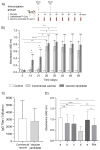Recombinant Subunit Vaccine Candidate against the Bovine Viral Diarrhea Virus
- PMID: 39201420
- PMCID: PMC11354329
- DOI: 10.3390/ijms25168734
Recombinant Subunit Vaccine Candidate against the Bovine Viral Diarrhea Virus
Abstract
Multivalent live-attenuated or inactivated vaccines are often used to control the bovine viral diarrhea disease (BVD). Still, they retain inherent disadvantages and do not provide the expected protection. This study developed a new vaccine prototype, including the external segment of the E2 viral protein from five different subgenotypes selected after a massive screening. The E2 proteins of every subgenotype (1aE2, 1bE2, 1cE2, 1dE2, and 1eE2) were produced in mammalian cells and purified by IMAC. An equimolar mixture of E2 proteins formulated in an oil-in-water adjuvant made up the vaccine candidate, inducing a high humoral response at 50, 100, and 150 µg doses in sheep. A similar immune response was observed in bovines at 50 µg. The cellular response showed a significant increase in the transcript levels of relevant Th1 cytokines, while those corresponding to the Th2 cytokine IL-4 and the negative control were similar. High levels of neutralizing antibodies against the subgenotype BVDV1a demonstrated the effectiveness of our vaccine candidate, similar to that observed in the sera of animals vaccinated with the commercial vaccine. These results suggest that our vaccine prototype could become an effective recombinant vaccine against the BVD.
Keywords: BVDV subgenotypes; E2 glycoprotein; bovine viral diarrhea virus; subunit vaccine.
Conflict of interest statement
The authors declare no conflicts of interest.
Figures







Similar articles
-
Immunogenicity evaluation of recombinant Lactobacillus casei W56 expressing bovine viral diarrhea virus E2 protein in conjunction with cholera toxin B subunit as an adjuvant.Microb Cell Fact. 2020 Oct 1;19(1):186. doi: 10.1186/s12934-020-01449-3. Microb Cell Fact. 2020. PMID: 33004035 Free PMC article.
-
Development of an APC-targeted multivalent E2-based vaccine against Bovine Viral Diarrhea Virus types 1 and 2.Vaccine. 2015 Sep 22;33(39):5163-71. doi: 10.1016/j.vaccine.2015.07.106. Epub 2015 Aug 13. Vaccine. 2015. PMID: 26279338
-
Dendritic Cell Targeting of Bovine Viral Diarrhea Virus E2 Protein Expressed by Lactobacillus casei Effectively Induces Antigen-Specific Immune Responses via Oral Vaccination.Viruses. 2019 Jun 25;11(6):575. doi: 10.3390/v11060575. Viruses. 2019. PMID: 31242608 Free PMC article.
-
Impact of species and subgenotypes of bovine viral diarrhea virus on control by vaccination.Anim Health Res Rev. 2015 Jun;16(1):40-54. doi: 10.1017/S1466252315000079. Anim Health Res Rev. 2015. PMID: 26050571 Review.
-
Control of bovine viral diarrhea infection by use of vaccination.Vet Clin North Am Food Anim Pract. 1995 Nov;11(3):615-25. doi: 10.1016/s0749-0720(15)30470-9. Vet Clin North Am Food Anim Pract. 1995. PMID: 8581866 Review.
Cited by
-
Host Immune Response to Bovine Viral Diarrhea Virus (BVDV): Insights and Strategies for Effective Vaccine Design.Vaccines (Basel). 2025 Apr 25;13(5):456. doi: 10.3390/vaccines13050456. Vaccines (Basel). 2025. PMID: 40432068 Free PMC article. Review.
References
-
- Goyal S.M., Ridpath J.F. Bovine Viral Diarrhea Virus: Diagnosis, Management and Control. Blackwell Publishing Professional; Ames, IA, USA: 2005.
MeSH terms
Substances
Grants and funding
LinkOut - more resources
Full Text Sources

